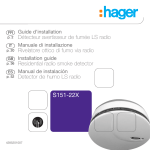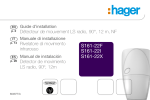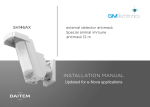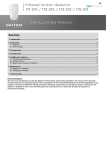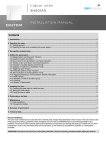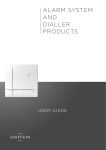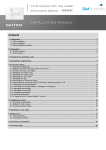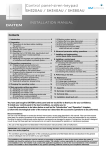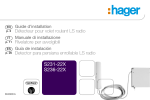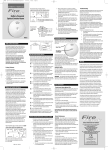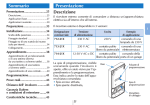Download Wireless Heat Detector - eNova Upgrade - 155-21X
Transcript
Upgraded for e-Nova applications GB Contents 1. introduction ................... 94 1.1 How the detector works......................... 94 1.2 Description................ 95 2. Power supply................. 96 3. Recognition programming ................. 96 4. installing the detector .. 97 4.1 Choosing the best place.......................... 97 4.2 Testing the radio range at the chosen location ..................... 98 4.3 Fixing the detector in place...................... 97 4.4 Installing several detectors in a network ............ 100 5. testing the detector.... 100 6. Manually disabling the detector ................. 103 7. indications ................... 104 7.1 Alerts ...................... 104 7.2 Faults ...................... 104 8. Maintenance................ 105 8.1 Servicing the detection head........ 105 8.2 Changing the battery .............. 106 8.3 During DIY work ..... 106 1. Introduction 1.1 How the detector works The heat detector detects rises in temperature that trigger an alarm in the following cases: • when the room temperature rises at an abnormal speed, or • when the room temperature reaches between 54°C and 70°C, (also refer to the table in the Technical Data section). iMPoRtAnt: the heat detector is designed to protect homes or the private areas of buildings. it is not designed for public assembly buildings or buildings housing workers. The heat detector is especially suitable for detecting fires that spread quickly or at an average speed and in places where an optical smoke detector cannot be used: • in a kitchen where there are cooking fumes, • in uninhabited places where there is a smoky atmosphere or a lot of dust (e.g. garages). iMPoRtAnt: the heat detector is not supposed to replace smoke or gas detectors to ensure the safety of people against smoke or gas, and notably in rooms such as bedrooms, playrooms and other living areas. The heat detector can be: • used as a stand-alone unit, • integrated into a Daitem alarm system, • interconnected in a hard-wired network of up to 40 detectors (heat or smoke). 9. technical data ............. 107 10. User sheet.................. 109 94 GB In stand-alone mode, the heat detector responds as follows during the heat detection period: When connected to a Daitem Red LeD indicating White LeD Sounding alarm system the detector detector status responds as follows when it a safety a built-in modulated alarm Heat detector the LED flashes detects heat: halo lights sounds on a continuous transmitting the heat quickly up basis (85 dB(A) at 3m) detection signal • triggering of the control a safety other hard-wired a built-in modulated alarm panel and security system halo lights sounds on a discontinuous interconnected heat wireless sirens in fire up detectors basis (85 dB(A) at 3m) sounding mode for 5 min., iMPoRtAnt: the heat detector should be replaced every • triggering of the telephone ten years. dialler. 1.2 Description Red LED indicating detector status Guarantee sticker Product replacement date Test button White LED (safety lighting when heat is detected) Programming key 0 Lithium battery connector guarantee sticker: remove the pre-cut part of the sticker and stick it to the guarantee certificate in the user manual supplied with the control panel. If you are adding the siren to an existing system, use the guarantee sticker provided with this product. 95 GB 2. Power supply Connect the lithium battery making sure it is the right way round. Ò The red LED flashes for 15 sec, then once every 10 sec to indicate that the detector is working normally. 3. Recognition programming iMPoRtAnt: during recognition programming, the product to be programmed for use with the control panel does not need to be placed next to it. in fact, we recommend you place the product at a short distance from the control panel (at least 2 m away). Programming enables the heat detector to be recognised by the control panel. To programme the heat detector, the control panel must be in installation mode. If it is not, press: then press: master code engineer installer code Carry out the programming sequence described below: ))) )) “beep, fire detector n° X” then 10 s max. Press * then # on the control panel keypad Press & hold the programming key 0 for 10 sec. until the control panel responds You can record a personalised message to identify the fire detector by voice (see the control panel installation manual, § on Voice identification message). 96 GB 4. Installing the detector Make sure there is a distance of at least 2 m between each product, except between two detectors. 4.1 Choosing the best place iMPoRtAnt: the heat detector is not supposed to replace smoke or gas detectors to ensure the safety of people against smoke or gas, and notably in rooms such as bedrooms, playrooms and other living areas. the heat detector is designed to detect fires in places where an optical smoke detector cannot be used. For basic protection, a smoke detector should be installed in at least each bedroom (refer to smoke detector manual). • far away from potential sources of electrical interference (electricity meter, metal cabinet, etc.), • if it is to be installed on a metal wall, insert a shim made of non-magnetic material (wood or plastic). the detector must be placed: • in rooms where there is a risk of fires spreading quickly or at an average speed, • in rooms with an aggressive or difficult environment such as kitchens (cooking fumes), garages (smoky atmosphere), and other unoccupied premises or rooms where there is often a lot of dust, • preferably at the centre of the ceiling but positioned so that it is affected by any abnormal rises in temperature, • if the detector cannot be installed in the centre of the ceiling, install it more than 50 cm away from the corners of the room (Fig. 1 and Fig. 2), • far away from ventilation grilles that may spread the heat, • more than 50 cm away from obstacles (walls, partitions, beams, etc.), • at either end of corridors more than 8 m long, the detector must not be placed: • in rooms where a sudden and considerable rise in the room temperature would cause untimely triggering of the alarms (e.g. sudden sunlight), • in rooms where there is a need to protect people against smoke or gas(bedrooms, children’s playrooms, converted cellars, occupied lofts, emergency exits, etc.), • near fluorescent tubes, • directly on a metal surface, • in a room where the temperature could drop below -10°C or rise above +55°C, as this will prevent the detector from operating properly, 97 GB 4.2 testing the radio range at the chosen location • in rooms where the relative humidity might rise above 95% (without condensation), • close to heating, cooling or air vents. iMPoRtAnt: the control panel must be in installation mode to perform this test (see Recognition programming). Mounting examples: Fig. 1 d > 50 cm 1. Hold down the detector programming key 0 or the test button until the built-in sounding can be heard: • correct: the control panel confirms the radio link with a voice message “beep, fire detector n° X”, • incorrect: if there is no voice message, move the heat detector closer to the control panel.le. plafond Recommended location Fig. 2 2. Put the control panel back in user mode by pressing: d > 50 cm engineer installer code 98 GB 4.3 Fixing the detector in place Standard fixing method 1. Install the base in the desired location, then mark the position of the 2 fixing holes (marked 60 or 85 ) using a pencil. 2. Drill holes using a 5 mm Ø drill bit. 3. Fix the base using appropriate plugs and screws. Fixing with flush-mounting box 1. For 60 mm diameter boxes: use holes marked 2. For 85 mm diameter boxes: use holes marked 3. Fix the base using suitable screws. iMPoRtAnt: to be able to thread the cables for surface mounting, remove the 2 fixing spacers and insert them between the ceiling and the mounting base by covering the 2 selected fixing holes. . 85 . 60 Align the 2 locating arrows marked on the mounting base and the detector, then lock the unit by turning clockwise. v Diameter 60 fixing holes Test button alignment marker Fixing spacers Diameter 85 fixing holes optional locking of the detector on the mounting base Optional locking is designed to prevent unauthorized dismounting of the detector. Using cutting pliers, cut the locking nipple. iMPoRtAnt: opening will now be possible only by means of a flat blade screwdriver. Locking nipple 99 iMPoRtAnt: the detector cannot be fixed to the base if the battery is not properly connected. Do not use force. GB 4.4 installing several detectors in a network It is possible to interconnect up to 40 detectors to enable alarm activation over the whole range of smoke and fire detectors installed in the home. iMPoRtAnt: 155-21X heat detectors can only be connected with the same type of detectors: e.g. a 155-21X can be connected with 155-21X heat detectors or 151-21X smoke detectors. You can therefore be sure of being warned if smoke is detected in a room far away from the room in which you are in. 1. Once the detector’s base has been fixed in place (see Fixing the detector in place), unclip the connector block. Connector block 2. Then wire as follows: Cable terminals Not used Signal Earth N For 15 mm2 wires, the overall network length must not exceed 400 m. 3. Clip the connector block back in place. 4. Lock the detector onto the base (see Fixing the detector in place). 100 GB 5. Testing the detector Although alarm sounding is reduced during a manual test of a heat detector, it is advisable to inform neighbours beforehand and to use all suitable hearing protection devices. iMPoRtAnt: so as not to cause a fire and damage the mechanical parts and the design of the device, never test it: • using a naked flame, • by moving it too close to a source of burning heat (e.g. a paint stripper, hair dryer, etc.). Detection head slot iMPoRtAnt: you can recognise this heat detector by the white slots in the detection head. Unlike the smoke detector, the smoke test spray (ref. teStFUM) is not suitable for testing heat detector operation. testing the detector using the test button: When you press on the “TEST” key for 10 sec., the detector performs an automatic functional self-test. Among other things, it examines the state of the heat sensor located behind the detection head slots and thus detects any defects linked to temperature measurement. If the heat sensor is faulty, the heat detector indicates that there is a technical fault (see Indications section). There is therefore no need to test the detector using a source of heat. 101 GB To test the heat detector, press on the test button (for roughly 10 sec.) until the built-in sounding is triggered. As long as the button is held down, the detector responds as follows: Red LeD indicating detector status White LeD Sounding Heat detector transmitting the heat detection signal the LED flashes quickly a safety halo lights up every second other hard-wired interconnected heat detectors the LED flashes quickly a safety halo lights up every second the alarm sounds for 1 sec (75 dB(A) at 3 m) and then stops for 1 sec the alarm sounds for 1 sec (75 dB(A) at 3 m) and then stops for 2 sec iMPoRtAnt: these tests should be carried out at least once a month and notably when you have been away for a long time. As soon as the test button is pressed for more than 10 sec, and when connected to a Daitem alarm system, the detector causes the following: • triggering of the control panel and security system sirens in fire sounding mode for 5 minutes, • triggering of the telephone dialler. Stop the sirens and check that the control panel has memorised the alarm (see Indications section). 102 GB 6. Manually disabling the detector It is possible to disable the detector for a 15 min period: • prior to activities likely to generate abnormal heat (fast rise in temperature or increase in room temperature above 54°C, e.g. during DIY work) and hence cause untimely triggering of the alarm, • to stop alarm sounding if non-dangerous heat is detected (e.g. sudden sunshine), (only possible with the detector having triggered the heat signal and which can be recognised by its flashing red LED). iMPoRtAnt: during the 15 min disable period, the detector will not detect any smoke or sound the alarm. In order to disable the detector, press the test button until the 1st beep sounds or until the detector stops its built-in sounding. The LED indicating the status of the detector flashes every 2 sec. Disabled heat detector other hard-wired interconnected heat detectors Red LeD indicating detector status White LeD Sounding the LED flashes every 2 sec. - - the LED flashes every 10 sec. - - Following the 15 min disable period, the detector is automatically reset to normal operation with the detector status LED flashing every 10 sec. iMPoRtAnt: to exit the disable mode before the end of the 15 min period, press the test button until you hear the built-in sounding (see response description in the testing the detector section). 103 GB 7. Indications... ... alerts When your alarm system is disarmed, the control panel will report the problem with the voice message “beep, date, time, fire alarm, detector n° X”. ... faults iMPoRtAnt: in order not to wake you up, audible alarms resulting from power problems or technical problems are shut down during the night. Any faults are indicated either after daybreak for a period of more than 10 minutes or 12 hours after their occurrence. Battery fault on the detector Red LeD indicating White LeD detector status Heat detector transmitting the fault signal other hard-wired interconnected heat detectors Sounding the LED flashes every 5 sec. - 2 fast beeps every 60 sec. - - - iMPoRtAnt: when a battery fault occurs, the detector continues to function perfectly for 30 days. nevertheless, it is advisable to replace the battery as soon as possible. If the sound indication of the battery fault occurs at an inappropriate time, it is possible to postpone its occurrence for an 8-hour delay over a maximum 7-day period by pressing the test button until you hear the 1st beep. This is the time period available for replacing the Lithium battery. Battery fault on the control panel Following a system command, the control panel issues the following voice message: “beep, fault, battery, detector n° X”. 104 GB technical fault Red LeD indicating White LeD detector status Heat detector transmitting the LED flashes 8 times every 8 sec. the fault signal other hard-wired interconnected heat detectors Sounding - 8 fast beeps every 58 sec. - - If this fault appears, replace the heat detector. Radio fault on the control panel Following a system command, the control panel issues the following voice message: “beep, fault, radio, detector n° X”. 8. Maintenance 8.1 Servicing the detector head You should vacuum-clean the detection head slots if there is a lot of dust in the room. Detection head slot iMPoRtAnt: we advise you to clean the detector using a soft cloth. never use alcohol or acetone to clean it. 105 GB 8.3 During DiY work 8.2 Changing the battery if the optional opening of the detector is not locked (see Fixing…) if the optional opening of the detector is locked (see Fixing…) 1. Remove the detector from its base by turning it counter clockwise until you hear a click. 1. Insert a flat blade screwdriver into this notch. v v 2. Replace the worn battery. 3. Lock the detector back onto its base (see Fixing...). 4. Carry out a test (see Testing the detector). 2. Remove the detector from its base by turning it counter clockwise until you hear a click. 3. Replace the worn battery. 4. Lock the detector back onto its base (see Fixing...). 5. Carry out a test (see Testing the detector). the detector must not be painted. If work is to be carried out in the room where the detector is installed, completely cover the detector using the plastic cover. iMPoRtAnt: do not forget to remove the plastic cover when the work is finished. • the lithium battery pack must be replaced by the same type of pack with the same technical characteristics, i.e. (3.6 V - 4 Ah). • We advise you to use the DAiteM BatLi26 pack available in the catalogue in order to guarantee individual safety and equipment reliability. Li • Dispose of the waste lithium power pack in an appropriate recycling bin. 106 GB 9. Technical data technical data Wireless heat detector 155-21X Type of detection Average coverage Height of support Use Power supply Battery life Red indication LED White LED Built-in sounding Hard-wired interconnection Network length Cable diameter Radio link Operating temperature Storage temperature Degree of mechanical protection Dimensions (Ø x H) Weight heat detector able to detect: • temperature rise speed • reaching of temperatures between 54 and 70°C (see next page) 30 m2 4.5 m max indoor 3.6 V lithium battery (BatLi 26) approximately 5 years in normal conditions of use • detector status • alerts triggered • faults safety lighting in case of detection • > 85 dB at 3 m in case of detection • > 75 dB at 3 m during testing or fault indication 40 detectors maximum 400 m maximum 1.5 mm2 maximum TwinBand® 800/400 MHz - 10°C to + 55°C (+75°C for a short duration) - 10°C to + 55°C / 95% relative humidity max. (without condensation) IP 32 125 x 48 mm 210 g 107 GB The heat detector will trigger an alarm: • if the temperature falls within the range given in the table below: (A2 class detector, response time according to EN 54-5, chapter 4.2) Minimum static response temperature 54 °C Maximum static response temperature 70 °C or • depending on the temperature rise speed (A2 class detector, response time according to EN 54-5, chapter 5.4.3) Air temperature rise speed ° C per minute 1 3 5 10 20 30 Response time lower limits Minute (minimum) 29:00 7:13 4:09 2:00 1:00 0:40 Response time upper limits Minute (maximum) 46:00 16:00 10:00 5:30 3:13 2:25 Examples: • if the temperature increases by 1 °C per minute then the heat detector should not trigger an alarm before 29 minutes have passed and should then trigger an alarm between 29 minutes and 46 minutes. • if the temperature increases by 30 °C per minute then the heat detector should not trigger an alarm before 40 seconds have passed and should then trigger an alarm between 40 seconds and 2 minutes and 25 seconds. 108 GB 10. User sheet (pull-out sheet for the user) Be prepared for a fire • Plan an evacuation route. • Prepare an evacuation plan for every room. • The least smoke is near the ground: crawl out of the house. • When the alarm sounds, wake everyone up. • Prearrange a muster point outside the house. • Avoid going into the house unnecessarily if there is a fire. • Call the fire brigade. During DiY work " the detector must not be painted. If work is to be carried out in the room where the detector is installed, completely cover the detector using the plastic cover provided. Do not forget to remove the plastic cover when the work is finished. Summary of your detector’s responses and indications normal operation Red LeD indicating White LeD detector status the LED flashes once every 10 sec. All heat detectors Sounding - - Heat detection (1) Red LeD indicating White LeD detector status Heat detector transmitting the heat detection signal other hard-wired interconnected heat detectors the LED flashes quickly - Sounding a safety a built-in modulated alarm halo lights sounds on a continuous up basis (85 dB(A) at 3m) a built-in modulated alarm a safety halo lights sounds on a discontinuous basis (85 dB(A) at 3m) up (1) The alarm will sound as long as abnormal heat is detected. Detector test (2) Red LeD indicating detector status White LeD Sounding Heat detector transmitting the heat detection signal the LED flashes quickly a safety halo lights up every second other hard-wired interconnected heat detectors the LED flashes quickly a safety halo lights up every second the alarm sounds for 1 sec (75 dB(A) at 3 m) and then stops for 1 sec the alarm sounds for 1 sec (75 dB(A) at 3 m) and then stops for 2 sec (2) Responses when the test button is pressed for longer than 10 sec and until the key is released. GB Battery fault indication Red LeD indicating White LeD detector status Heat detector transmitting the fault signal other hard-wired interconnected heat detectors Sounding the LED flashes every 5 sec. - 2 fast beeps every 60 sec. - - - technical fault indication Red LeD indicating White LeD detector status Heat detector transmitting the LED flashes 8 times every 8 sec. the fault signal other hard-wired interconnected heat detectors Sounding - 8 fast beeps every 58 sec. - - Manual disabling of the detector To prevent users from being disturbed at inconvenient times, audible indications of a battery fault or technical fault can be delayed for 8 hours over a maximum period of 7 days by holding the test button pressed until the first beep sounds. You should contact your installation engineer within this same period in order to rectify the problem. in order not to wake you up, audible indications of a battery fault or a technical fault are shut down during the night. Any faults are reported either after daybreak for a period of over 10 min or 12 hours after their occurrence. It is possible to disable the detector for a 15 min period: • prior to activities likely to generate abnormal heat (sudden rise in temperature or rise in room temperature of above 54°C, e.g. during DIY work), and cause unwanted alarm activation, • to stop the alarm when the heat generated is not dangerous (e.g. sudden sunshine), (only possible with the detector having detected the rise in temperature and which can be recognised owing to the flashing of its red LED). In order to disable the detector, press the test button until the 1st beep sounds or until the detector stops its built-in audible alarm. The LED indicating During this 15 min. period, the status of the detector flashes every 2 sec. Disabled heat detector other hard-wired interconnected heat detectors Red LeD indicating detector status White LeD Sounding the LED flashes every 2 sec. - - the LED flashes every 10 sec. - - the detector will be unable to recognise heat or generate alarms. Following the 15 min disable period, the detector is automatically reset to normal operation and its indication LED flashes every 10 sec. GB To obtain advice when installing your system or before returning equipment, please contact the Daitem technical support team (see telephone number at the back of the alarm system installation manual). A team of qualified technicians will tell you what to do. ATRAL SYSTEM - F-38926 CROLLES CEDEX www.daitem.co.uk DeCLARAtion oF ConFoRMitY Manufacturer: Hager Security SAS Address: F-38926 Crolles Cedex - France Product type: Wireless heat detector Trade mark: Daitem We declare under our sole responsibility that the product to which this declaration relates is compliant with the essential requirements of the following directives: • R&tte Directive: 99/5/eeC • Low voltage directive: 2006/95/eC in compliance with the following harmonised European standards: Products code en 300 220-2 V2.1.2 en 50130-4 (95) + A1 (98) + A2 (2002) en 60950 (2006) en 301 489-1 V1.8.1 155-21X X X X X This product can be used in all EU, EEA Countries and Switzerland. Crolles, 02.01.2013 Signature : Patrick Bernard Director of Research and Development Non-binding document that may be modified without notification. 111 13 2280612004 - 01.2013






















